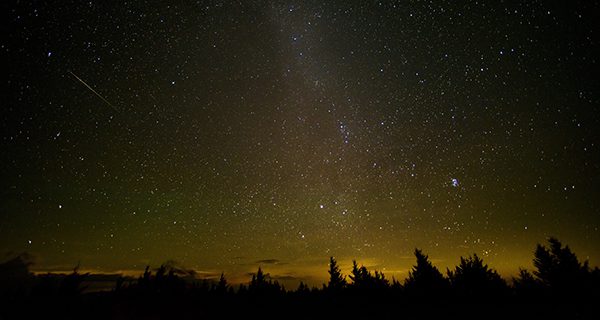By Stephen Press
Hometown Weekly Editor
Casual stargazers in Hometown Weekly’s communities are gearing up this week for some extraterrestrial visitors in the form of the annual return of the Perseid meteor shower. The Perseids, which represent one of the year’s more reliably excellent displays of falling stars, are peaking now through this Sunday, August 14 (with their absolute height coming on August 13), promising a celestial light show for anyone willing to venture out after dark.
What stands between Hometown Weekly readers and a top-notch amateur astronomy experience? Outside of the weather and a little light pollution, not a whole heck of a lot.
The Perseid meteor shower occurs when the earth passes through the trail of debris left by comet Swift-Tuttle. When the debris comes in contact with the earth’s atmosphere, it spectacularly burns up, precipitating meteors (or shooting stars, as they’re also known). How they burn is part of the fun. Some will fall in straight, white streaks that are over in a snap, while others might linger a slight bit longer, displaying colors as they plunge into the planet. This writer has even been fortunate to see a particularly unforgettable one that lasted a full second or two, with noticeable pieces burning off as it fell. While this sighting was truly a once-in-a-lifetime event, the Perseids are known to contain a higher proportion of this more “deluxe” variety of meteor, which scientists refer to as a fireball. It makes for an especially fun watch. During the height of the shower, meteors can fall at rates of up over one per minute — frequent enough to make it well worth your while to stare at the heavens (and to keep the kids interested).
So, how does one best enjoy this yearly astronomical display?
Unfortunately, a full moon on August 11 will make for slightly brighter viewing conditions than usual. This, however, needn’t be an impediment; this writer has viewed the Perseids on many occasions, including those with abundant moonlight, and never found the lunar light to put that much of a damper on the proceedings (though I will also readily admit, a moonless night is ideal).
The meteors appear to originate from the constellation Perseus, hence the name “Perseids.” Because Perseus is highest and most visible in the northeastern sky just before dawn, this is the ideal time to head out to view the falling stars. Your absolute best bet is to find an unobstructed view towards the northeast, get comfortable (perhaps with an extra-early morning coffee in hand), and wait patiently.
But what about those of us who’d rather not set an alarm that early — especially those of us with kids who might balk at the idea of an early call time in the interest of scientific enrichment?
Fortunately, you have an option, as well: stargazers can have plenty of luck heading out to their backyards and scanning the heavens as early as 10 p.m. While many of the meteors will be below the horizon at this time, those that do appear in the sky will have a higher likelihood of being “earth-grazers” — that is, meteors that just scratch the earth’s atmosphere, lasting longer and producing a more spectacular light streak behind them.
Admittedly, slight complications abound. Light pollution, both from the moon and civilization, will necessarily decrease the number of shooting stars you’ll be able to see. So will trees in your line of sight, or potential cloudy nights. So will the kids’ (or your own) unwillingness to head out before dawn, or to a location with an unobstructed view.
Don’t let any of that discourage you.
Watching the Perseids from a backyard blanket with my family as a child — even with all of those aforementioned complications in play — is still among the more endearing memories I have. Summer nights are precious, they’re fewer in number with every passing day, and the ones this week come with a free light show; if now isn’t the time to enjoy one, then what is?























